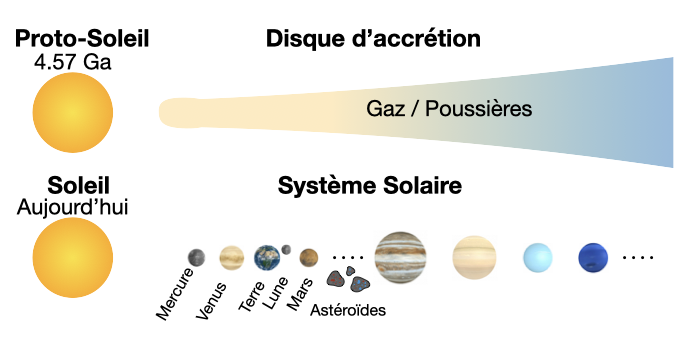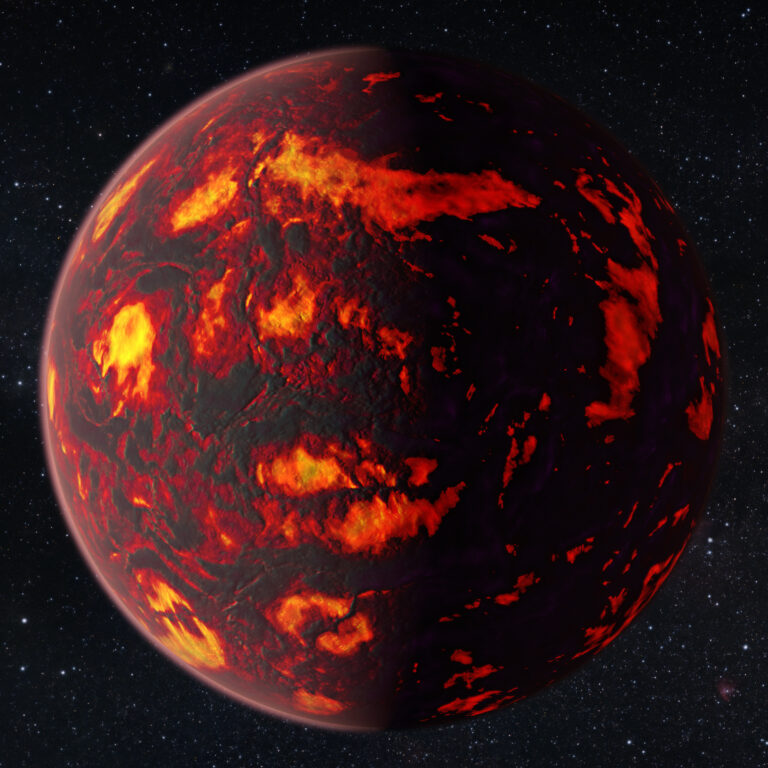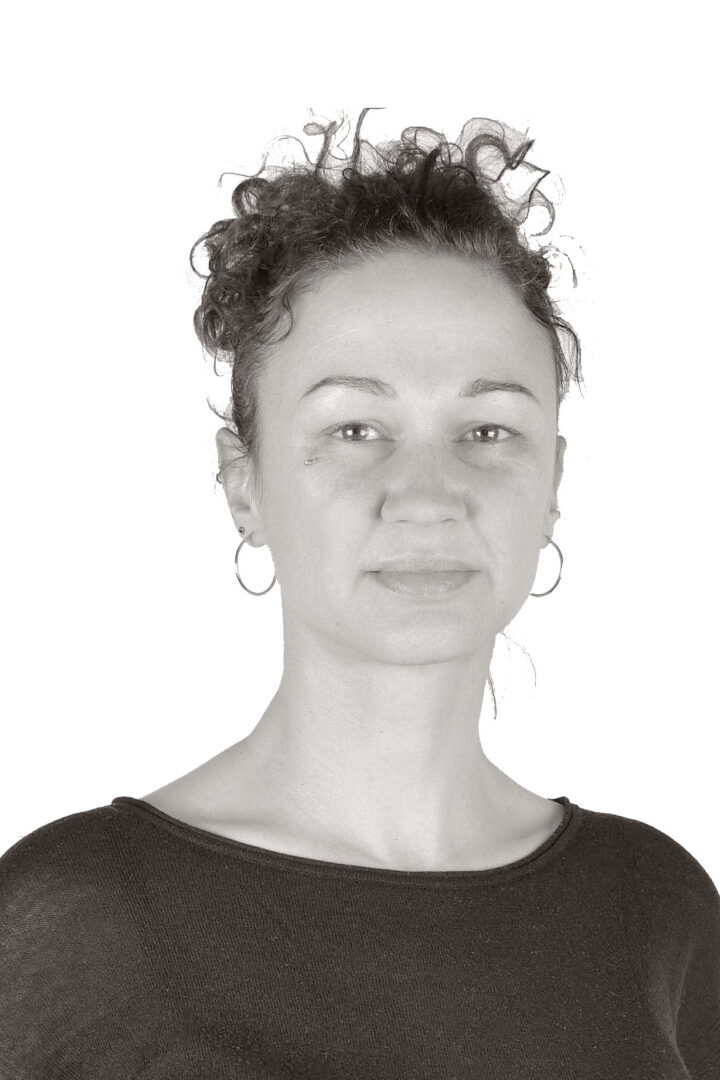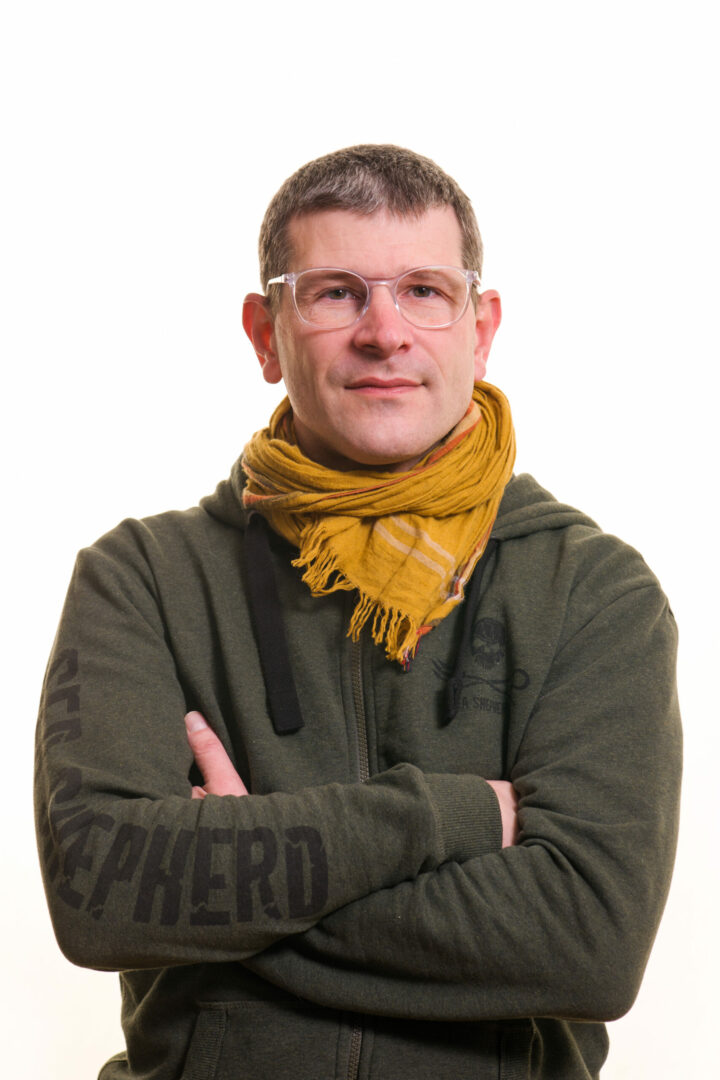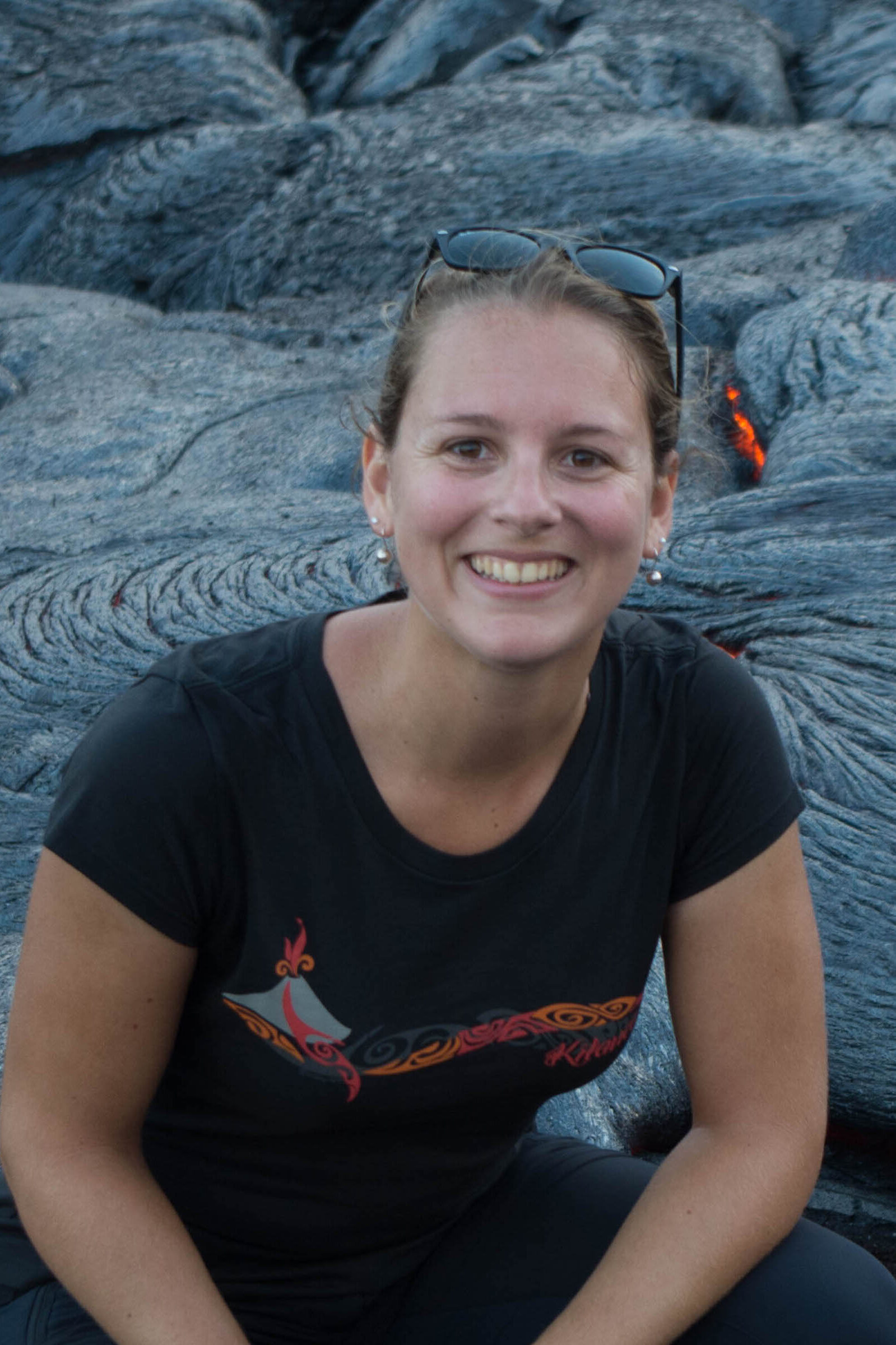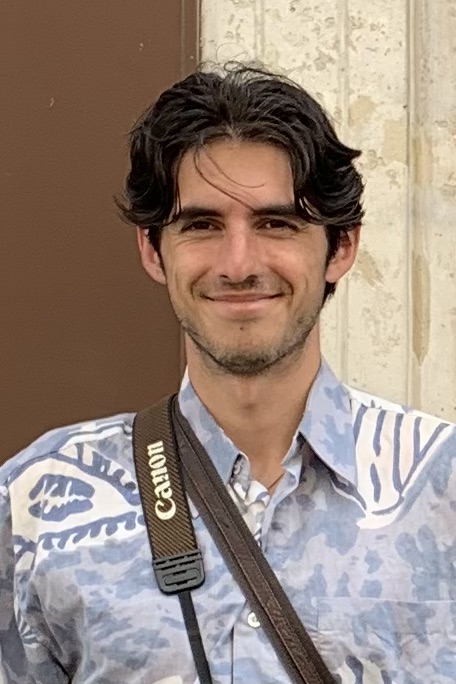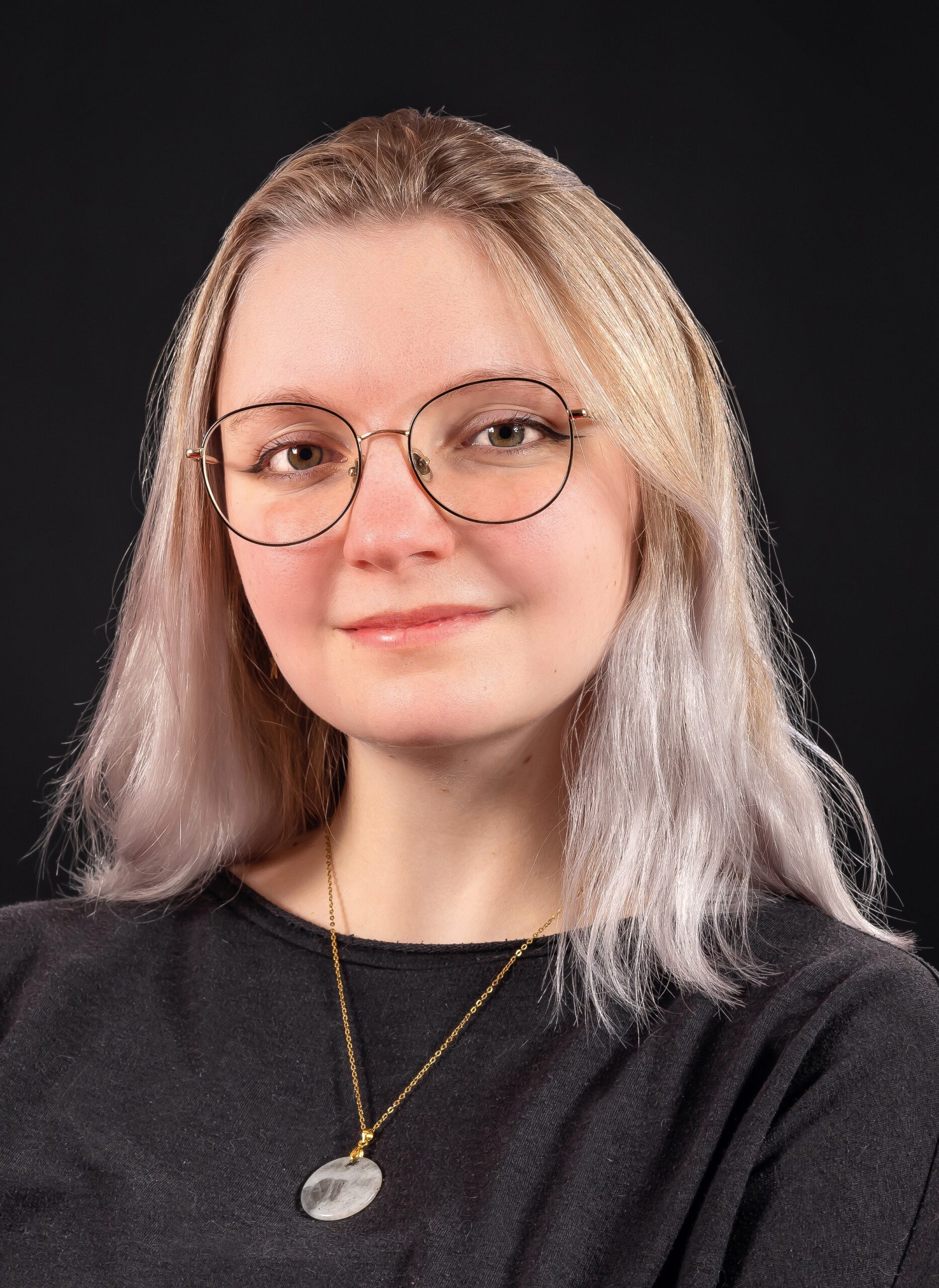DESCRIPTION
The Sun formed from the local collapse of a dense molecular cloud 4.57 billion years ago. Some of the dust and gas from the molecular cloud remained in orbit around the forming Sun, constituting an accretion disk from which the planets and different solar system bodies have formed.
Although the main stages of the formation of the solar system are broadly understood, the detailed conditions of formation of the first solids and of the accretion and early evolution of planetesimals, as well as the chronology of events leading to the formation of the Earth and the other rocky planets remain largely unknown today. The physicochemical conditions prevailing within and at the surface of the young Earth, as well as the presence of liquid water, surely played a dominant role in the Earth’s early geodynamic evolution and, ultimately, in the emergence of life.
The main objective of this theme is to progress our understanding of what has made our solar system unique and, within it, the planet Earth. To this end, theme researchers develop approaches combining mineralogical, petrographic, chemical and isotopic studies of both terrestrial and extraterrestrial materials, analyses of remotely sensed data and experimental simulations. This work is conducted through both laboratory studies and the involvement of theme researchers in the exploration programmes of international space agencies.
LIFE IN THE THEME
Current theses
Marine Joulaud – Caractérisation multi-échelle des régolites de la Lune et de Mercure par imagerie et modélisation numérique
Supervisors: Pascal Allemand & Vincent Langlois (Université Lyon 1), Jessica Flahaut & Evelyn Füri
Baptiste Le Bellego – Approche expérimentale du fractionnement isotopique du germanium dans les conditions de formation du noyau d’accrétion des planétésimaux.
Supervisors: Béatrice Luais & Célia Dalou
Belen Muñoz-Rojas – Central Andes mafic volcanism as an analog to Mars
Supervisors: Jessica Flahaut & Mary Ford (CRPG), Patricia Larrea (Universidad de Chile)
Julie Gamblin – Nitrogen in metal-rich meteorites: distribution and evolution of nitrogen in the protoplanetary disk
Supervisors : Evelyn Füri & Béatrice Luais
Clarisse Peignaux – VNIR spectroscopy of martian granitoids : identification and origin
Supervisors : Jessica Flahaut & François Faure
Mahaud Chavanieu – Carbon and Sulfur Isotopic fractionations during magma ocean outgassing: comparison of Earth’s and Mars’ primitive atmosphere.
Supervisors : Célia Dalou & Béatrice Luais
Defended theses
8 mars 2024 – Marie Barthez – Apport de la spectroscopie dans l’infrarouge proche (VNIR) à l’étude de l’origine et du mode de formation des roches feldspathiques martiennes.
Supervisors: Jessica Flahaut & Raphaël Pik
8 décembre 2023 – Dorian Thomassin – Hydrogen in the high-temperature phases of chondrites: origin and contribution to the hydrogen budget of the rocky planets.
Supervisors: Laurette Piani / Yves Marrocchi
29 mars 2023 – Maxime Piralla – Origine et chronologie des premiers objets du système solaire.
Direction : Johan Villeneuve / Yves Marrocchi
17 mars 2023 – Gabriel Pinto – Condition de formation et d’agglomération de poussière dans le système solaire primitif.
Direction : Yves Marrocchi
14 mars 2023 – Nicolas Schnuriger – Conditions redox de la formation des chondres et de leurs précurseurs.
Direction : Camille Cartier / Yves Marrocchi
2 décembre 2022 – Matthieu Almayrac – Noble gas behavior in cometary ices under irradiation.
Direction : Bernard Marty / Laurette Piani
8 avril 2022 – Marion Auxerre – Cristallisation des olivines dans les chondres barrés et macro-porphyriques.
Direction : François Faure
14 décembre 2021 – Cécile Deligny – Chronologie et origine des éléments volatils dans le Système Solaire interne : Contraintes grâce à l’analyse in-situ des achondrites.
Direction : Evelyn Füri et Etienne Deloule
Contact actuel : Freie Universität Berlin
18 décembre 2020 – Julien Boulliung
Solubilité, spéciation et diffusion de l’azote dans les verres et silicates fondus. Direction : Evelyn Füri & Yves Marrocchi (CRPG)
Contact actuel : University of Oxford
30 juin 2020 – Guillaume Florin
Condensation et évolution du métal Fe-Ni dans le Système Solaire jeune : systématiques des isotopes du germanium et des éléments sidérophiles dans les chondrites primitives (chondrites Ordinaires et Bencubbinites). Direction : Béatrice Luais (CRPG), Tracy Rushmer, Université de Macquarie, Sydney, Australie &
Olivier Alard, Géoscience Montpellier, France
Contact actuel : Freie Universität Berlin
Major projects
ERC IRONIS – Evelyn Füri – 2023/2028
ANR CSI-Planet – Célia Dalou – 2023/2027
CNRS-IRP international ImpactGEM – Béatrice Luais – 2023/2028
ANR PlanetGEM – Béatrice Luais – 2021/2025
ANR MARS-Spec – Jessica Flahaut – 2021/2024
ANR HYDRaTE – Laurette Piani – 2020/2024
ANR CASSYS – Johan Villeneuve – 2019/2023
ERC VOLATILIS – Evelyn Füri – 2017/2022
ERC PHOTONIS – Bernard Marty – 2017/2022
Public outreach
Books:
- EN AVANT MARS ! written by Nicolas Beck, Jessica Flahaut, Sylvain Breton and published in 2022 at EDP edition (book in French).

Articles by theme researchers in The Conversation:
- Avec Mars, une nouvelle ère pour la recherche d’échantillons extraterrestres (publié le 19/02/2021)
- Récit animé : 50 ans de missions spatiales et un avenir à écrire (publié le 19/02/2021)
- Why is there water on Earth? (publié 11/02/2021)
- Why is the Earth blue? (publié 03/02/2021)
- Pourquoi y a-t-il de l’eau sur Terre ? (publié le 18/10/2020)
- La Terre a-t-elle toujours été bleue ? (publié le 18/10/2020)
Visits to the CHU Nancy-Brabois children’s hospital with the association Les p’tits cueilleurs d’étoiles (The little star gatherers)
 Les p’tits cueilleurs d’étoiles brings activities related to space and meteorites to hospitalised children.
Les p’tits cueilleurs d’étoiles brings activities related to space and meteorites to hospitalised children.
Live event — “Après tout” (After all) (2020–2021), created by the company Présomption de presence (Presumption of presence)

A musical and choreographic play on the theme of the growth of the Earth, from its accretion, differentiation and the stabilisation of its outer layers, until the evolution of primitive life forms at its surface and the major extinctions. Multiple recent research projects of CRPG researchers (the age of chondrites, the evolution of the primitive atmosphere, the stabilisation of the continental crust, the origin of water on Earth) inspired the text presented during this choreographic concert.
Webpage of the play – https://presomptionsdepresences.com/Apres-tout-1
Website of the company – https://presomptionsdepresences.com/
Coffee talks (cafés Cosmo-Planéto)
Future talks:
| Date et heure | Description |
|---|---|
|
28 November 2025 13:15 |
Kana Amano (IAS, Paris) The iron redox states of the building blocks of the outer solar system |
Past talks:
| Date et heure | Description |
|---|---|
|
19 September 2025 13:15 |
Jean-Christophe Viennet (MNHN, Paris) Pre-accretionary origin of clay minerals in CI chondritic objects ? Insights from the Orgueil meteorite clay mineralogy and iron oxidation state. |
| Date et heure | Description |
|---|---|
|
29 August 2025 13:15 |
Discussions / Conférences Discussions / Conférences |
| Date et heure | Description |
|---|---|
|
6 June 2025 00:00 |
Journée cosmo-planéto Journée cosmo-planéto |
| Date et heure | Description |
|---|---|
|
11 April 2025 13:15 |
Virgile Malarewicz (MNHN/ Université Paris-Saclay) Quartz, granites et brèche martienne : une fenêtre sur l’évolution de la croûte primitive |
|
4 April 2025 13:15 |
Giovanna Agrosì (Università di Bari Italy) New insights into (Al, Cu)-bearing micrometeorites from Mt. Gariglone (Italy) |
| Date et heure | Description |
|---|---|
|
10 January 2025 13:15 |
Marwane Mokhtari (ENS Lyon) Conditions de formation des composants chondritiques : expériences et modèles |
| Date et heure | Description |
|---|---|
|
18 October 2024 13:15 |
Laurette / Yves / Johan – OSIRIS-REx Premiers résultats du groupe analyses élementaires et isotopiques de Bennu – Mission OSIRIS-REx |
| Date et heure | Description |
|---|---|
|
27 September 2024 13:00 |
Marine Joulaud (LGL,TPE Lyon, CRPG) The regolith thickness on the Moon: insights from 2d numerical simulations of impact craters |
| Date et heure | Description |
|---|---|
|
19 April 2024 13:15 |
Yves Marrocchi / Laurette Piani (CRPG) First SIMS results obtained on Bennu’s samples |
| Date et heure | Description |
|---|---|
|
29 March 2024 13:00 |
Julie Gamblin (CRPG) Dissecting the complex Ne-Ar-N signature of asteroid Ryugu by step-heating analysis |
Members
Researchers
Post-doctorate fellows
PhD students
RECENT PUBLICATIONS BY THEME RESEARCHERS
The quest for water
Marrocchi, Y.; Beck, P. Elements, 2022, 18, 149-153
The EXCITING experiment exploring the behavior of nitrogen and noble gases in interstellar ice analogs
Almayrac, M.G.; Bekaert, D.V.; Broadley, M.W.; Byrne, D.J.; Piani, L.; Marty, B. The Planetary Science Journal, 2022, 3, 252
Origin of water in the terrestrial planets: Insights from meteorite data and planet formation models
Izidoro, A.; Piani, L. Elements (2022) 18 (3): 181–186
Noble gases and nitrogen in samples of asteroid Ryugu record its volatile sources and recent surface evolution
Okazaki, R.; Marty, B.; Busemann, H.; Hashizume, K.; Gilmour, J.D.; Meshik, A.; Yada, T.; Kitajima, F.; Broadley, M.W.; Byrne, D.; Füri, E.; et al. Science, 2022, abo0431
First asteroid gas sample delivered by the Hayabusa2 mission: A treasure box from Ryugu
Okazaki, R.; Miura, Y.N.; Takano, Y.; Sawada, H.; Sakamoto, K.; Yada, T.; Yamada, K.; Kawagucci, S.; Matsui, Y.; Hashizume, K.; Ishida, A.; Broadley, M.W.; Marty, B.; Byrne, D.; Füri, E.; et al . Science Advances, 2022, 8, eabo7239
Assessing the distribution of water ice and other volatiles at the Lunar South Pole with LUVMI-X: A mission concept
Losekamm, M.J.; Biswas, J.; Chupin, T.; Deiml, M.; Deremetz, M.; Evagora, A.M.; Fau, G.; Flahaut, J.; Gancet, J.; Glier, M.; Gscheidle, C.; Joulaud, M.; et al. The Planetary Science Journal, 2022, 3, 229
16O-rich anhydrous silicates in CI chondrites: Implications for the nature and dynamics of dust in the solar accretion disk
Morin, G.L.F.; Marrocchi, Y.; Villeneuve, J.; Jacquet, E. Geochimica et Cosmochimica Acta, 2022, 332, 203-219
Heterogeneous nature of the carbonaceous chondrite breccia Aguas Zarcas – Cosmochemical characterization and origin of new carbonaceous chondrite lithologies
Kerraouch, I.; Kebukawa, Y.; Bischoff, A.; Zolensky, M.E.; Wölfer, E.; Hellman, J.L.; Ito, M.; King, A.; Trieloff, M.; Barrat, J.A.; Schmitt-Kopplin, P.; Pack, A.; Patzek, M.; Hanna, R.D.; Fockenberg, T.; Marrocchi, Y.; et al. Geochimica et Cosmochimica Acta, 2022, 334, 155-186
Origin of radiogenic 129Xe variations in carbonaceous chondrites
Avice, G.; Meier, M.M.M.; Marrocchi, Y. Geochemical Perspectives Letters, 2022, 23, 1-4
Samples returned from the asteroid Ryugu are similar to Ivuna-type carbonaceous meteorites
Tetsuya Yokoyama, Kazuhide Nagashima, Izumi Nakai, Edward D Young, Yoshinari Abe, Jérôme Aléon, Conel M O’D Alexander, Sachiko Amari, Yuri Amelin, Ken-ichi Bajo, Martin Bizzarro, Audrey Bouvier, Richard W Carlson, Marc Chaussidon, Byeon-Gak Choi, Nicolas Dauphas, Andrew M Davis, Tommaso Di Rocco, Wataru Fujiya, Ryota Fukai, Ikshu Gautam, Makiko K Haba, Yuki Hibiya, Hiroshi Hidaka, Hisashi Homma, Peter Hoppe, Gary R Huss, Kiyohiro Ichida, Tsuyoshi Iizuka, Trevor R Ireland, Akira Ishikawa, Motoo Ito, Shoichi Itoh, Noriyuki Kawasaki, Noriko T Kita, Kouki Kitajima, Thorsten Kleine, Shintaro Komatani, Alexander N Krot, Ming-Chang Liu, Yuki Masuda, Kevin D McKeegan, Mayu Morita, Kazuko Motomura, Frédéric Moynier, Ann Nguyen, Larry Nittler, Morihiko Onose, Andreas Pack, Changkun Park, Laurette Piani, et al.
Science, 2022





